by Marion Patterson | May 9, 2019 | (Sub)Urban Homesteading, Bugs, Foraging, Garden/Yard, Nature, Uncategorized
A delightful swatch of color flitted by as we sat on our back deck on one of spring’s first warm sunny days. It was a red admiral butterfly that landed on a post just a few feet from us. It appeared to be enjoying the weather as much as we were.
We’ve since spotted many red admirals in the yard, probably because stinging nettles thrive on the north end of our property. It’s the favored plant for red admiral caterpillars, although they’ll also live on other types of nettles. That poses somewhat of a dilemma.
What is a Red Admiral Butterfly?
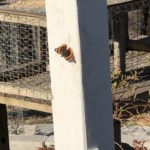
These colorful butterflies depend on early blooming plants like nettles.
Red Admirals are a common butterfly across much of the temperate globe. They’re found across Europe and Asia, North Africa, Hawaii, and much of North America, especially the eastern half of our continent. The larvae feed on stinging nettles, which may not be native. So, if red admirals need stinging nettles what did they eat before the plant was introduced to North America in the early days of European exploration? It’s not even certain that stinging nettles are exotic. They may have been here all along, or early butterflies may have fed on wood nettles.
We appreciate both the insect and plant here at Winding Pathways. Red admirals add color and movement to the yard, while nettles make delicious eating. It’s the first wild green we harvest each early spring.
Can You Eat Nettles?

Carefully pluck the top three leaves off.
Stinging nettles are ready to harvest early – about the time when chard, spinach, and lettuce are planted. When the nettles are just a few inches tall we pluck off the top three or four leaves. They are called stinging nettles because the plant has tiny hairlike stingers. Walk through a patch in summer wearing shorts and nettles cause instant pain. But it’s temporary and not dangerous. Another name for the plant is the “seven-minute itch.” The sting comes from histamines.
We gather young nettles without getting stung by carefully plucking just the top leaves between our thumb and forefinger and snapping them off. About 100 young nettle tops make two servings. We bring them into the kitchen, rinse them a couple of times, and steam them for just a minute or two. The sting disappears and resulting greens are delicious. Plus they pack a nutritious array of vitamins and are high in protein.
Nettle season is short. By the time the plants are eight or ten inches tall, the new leaves are getting tough. But by then we’re harvesting chard and spinach from the garden.
We’re happy to share our yard with both red admirals and nettles. Anyone with a partly shady yard with damp soil might want to start a nettle patch. Wear a pair of gloves and dig up a few and plant them in the yard. They aren’t fussy and will provide excellent table fare and a higher likelihood that the yard will be home to the colorful butterfly.
by Winding Pathways | Nov 15, 2018 | (Sub)Urban Homesteading, Bugs, Flowers/Grasses, Garden/Yard, Garden/Yard, Nature

Butterfly on plant
This past summer we enjoyed watching many monarch butterflies flutter over our prairie labyrinth. Numbers were way up from last year.
These intrepid insects are now en route to wintering grounds in Mexico. We look forward to their return next year.
Monarchs suffered huge population declines due to varied stresses on their lives. In farm country, most fencerows, waterways, and pastures that once harbored milkweed and wildflowers that provided both caterpillars and adults with food have disappeared. Today’s farmland is a pesticide-laced monoculture of just a few crops.
In town, manicured and sprayed lawns are as devoid of diversity as a cornfield and can’t sustain beautiful wildlife like butterflies.
The news would be more distressing had people not responded with enthusiasm to the monarchs’ decline. This summer we were delighted to see dozens of homeowners in Cedar Rapids and other towns let their lawns grow taller. Many planted pollinator patches in even tiny yards that include a diversity of native plants, including milkweeds. We took joy in seeing a small patch of milkweeds nurtured by the staff of a convenience store in a tiny patch of dirt near the gas pumps.

Grow a wild patch on your lawn to encourage butterflies.
Every pollinator patch, even if tiny, adds beauty and diversity to our world. We urge everyone to assist wildlife by creating natural plantings, even in urban areas.
Many Iowans have been inspired by the Monarch Zones Project. Founded by Clark McLeod, the Project provides workshops, encouragement, equipment, and seeds to help people assist this beautiful insect and hundreds of other beneficial species that add richness to our lives and health to the environment.
Next spring’s planting season isn’t far off. Now’s a fine time to plan to expand or create a pollinator patch in the yard. For help contact Monarch Research Project. Let’s continue to work together to create wondrous yards.
Bon voyage, Monarchs!
by Winding Pathways | Sep 27, 2018 | Bugs, Nature, Pests
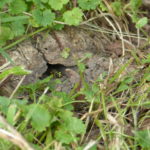
Yellow Jackets work the day shift.
We were recently concerned to find a Yellow Jacket nest close to our front door. Normally we appreciate their ambitious work catching insect prey. If they had made their nest in an out of the way place, we would have left them alone. But, their nest location invited painful stings to us or visitors. They had to go.
Several species of Yellow Jackets live in the United States. Most make an underground nest that can have an opening on the soil surface upwards of an inch in diameter. It can be nearly anywhere, but the nest we found was beneath the lawn next to the walkway into the house.
Yellow Jacket queens overwinter and begin laying eggs in the spring. By late summer or fall, the few Yellow Jackets that were around in spring have multiplied into colonies that can have hundreds of individuals. The workers die in late fall.
Many people discover a Yellow Jacket nest when they walk by it or mow the lawn over the entrance. Angry insects instantly attack and often a hapless person is stung many times in a second or two. Stings really hurt. It’s happened to us more than once, so now we don’t tolerate a nest near the house.
We only kill a Yellow Jacket colony if it’s located where we, or visitors, might be stung. Here’s how we do it:
Yellow Jackets work the day shift. Although they sometimes are out flying in the early evening by dark the entire colony is home underground in the nest. The nest entrance is easily spotted during the day by dozens of Jackets coming and going. We note its location. After dark we approach with a flashlight, spray can of insect killer, and a piece of cardboard, a board, or an old hunk of carpet. The flashlight helps find the hole. We spray a generous amount of poison down the hole, cover it with the carpet, board, or cardboard and weight it down with a rock. The covering keeps the spray in the nest.
The next morning, we watch for Yellow Jacket activity. Usually, there is none, telling us we destroyed the colony. We remove the covering, but if we see some Yellow Jackets we respray at night and cover the nest again. That usually solves the problem.
by Marion Patterson | Sep 7, 2018 | Bugs, Nature, Wonderment
Guest Blogger, Sheryl Ochs
On a jaunt to the garden to retrieve some herbs for my freshly cooked carrots, I paused in surprise to see 12 small black caterpillars, each with a tiny white stripe in the middle, chomping away on my only parsley plant.
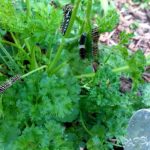
Caterpillars happily munch parsley leaves.
I knew that parsley was a butterfly host plant, and I knew that Swallowtail butterflies were partial to it, but the only ones I’d noticed before were bigger, fatter and striped with yellow/green.
Seeking advice from a trusted website, I discovered the tiny black caterpillars were indeed the first instars of the caterpillars on their way to becoming Swallowtail butterflies. As I watched what I called “my children” grow, I saw each of the four instar stages in which they shed their skin.
Each morning and evening I’d head to the garden to make certain they had not succumbed to hungry birds or other predators and each time I was relieved to count 12.
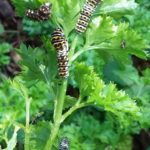
Caterpillars on parsley.
Before the caterpillars finally vacated, they mostly decimated my parsley leaving only a small sprig for my next dish of carrots. A small price to pay for the pleasure of watching them grow to adulthood. Now they’ve meandered off to form their chrysalises and I anxiously await an influx of beautiful butterflies to grace my yard.
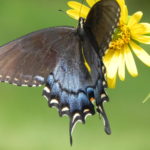
Black Swallowtail butterfly on cup plant.
by Winding Pathways | Jul 26, 2018 | (Sub)Urban Homesteading, Birds, Bugs, Flowers/Grasses, Garden/Yard, Nature, Reflections/Profiles, Wonderment
The Gazette in Cedar Rapids has had several interesting nature stories connected to creating wondrous yards. Living Section features “Birds do it, Bees do it”, “Add a Little Luck to Your Landscape” and Purslane (by Winding Pathways). We loved reading about the birds and bees’ cooling strategies and welcomed the return of clover to yards as natural nitrogen fixers and deep-rooted water retention plants. And, of course, we love to eat purslane. Let us know ways you fix this healthy vegetable.
Also an article on wasps of late summer. They are beneficial, ‘though deserve keeping distance.
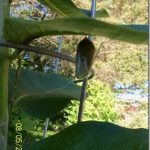
Success on the Bena Farm!
Best of all was the picture of the Monarch Chrysalis from friends, Nancy and Gordon Bena found on their farm. Let’s keep encouraging habitat for insects that form the basis of life for many other creatures.
by Winding Pathways | May 17, 2018 | Bugs, Garden/Yard, Nature, Pests
Creepy Crawlers
Even before Lyme disease created a serious tick-borne health hazard no one wanted ticks crawling on them. We sure don’t want them at Winding Pathways and because our yard has tall grass, shrubs, and a woodland we have tick habitat.
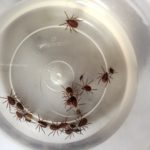
Collection of ticks
A few years ago, Rich contracted Lyme Disease caused when a tick injected bacterium into him. Thanks to a wise physician and effective antibiotics he was cured, but it’s possible to get Lyme Disease again and again. We’re more cautious about avoiding ticks now.
Ticks of many species live throughout most of the United States. They’re common in brushy, grassy, and woodsy habitat but they also love living in yards. It’s possible for a tick to enjoy a human meal even if that person never leaves a mowed yard.
Natural Tick Predators
Although naturalized yards are sometimes good tick habitat they also attract tick predators that love to snack on the tiny invertebrates. Many small birds, including warblers, wrens, and brown creepers among them quickly convert any tick they find into lunch.
Possums Are Us!

Opossums groom themselves carefully.
A newly understood tick-lover is the common opossum. Many people consider this ancient marsupial a homely animal and would prefer to not have one in their yard, but they might want to rethink this. According to the Carey Institute, opossums are tick vacuum cleaners. As they walk through a yard ticks hitch a ride, thinking they will be able to burrow into the animal’s skin and feast on warm blood. The tick doesn’t realize that possums groom their fur often and comb out ticks. These are readily eaten by the always hungry mammal. Having an opossum in the neighborhood can reduce tick numbers.
Foxes and Coyotes
Small predators, like the fox, are also valuable in tick reduction. According to a study by Dr. Hofmeester, Foxes and coyotes eat mice that ticks feed on. Ticks need three meals before they can reproduce, so more foxes and coyotes can reduce the mouse population and thus, the tick population by “…breaking the cycle of infection.”
Life Cycle
Tick numbers are also associated with climate change and abundance of food. Dr. William H. Schlesinger in an April 2018 issue of Citizen Scientist wrote about the work of Rick Ostfeld with the Carey Institute. The occurrence of ticks one year relates to mice numbers the year before, which relates to food abundance in previous years. The chain of life! And, according to Ostfeld, white-tailed deer are less implicated, unlike initial beliefs, and turkeys also appear to help reduce tick numbers. That is great news for us at Winding Pathway because the wild turkeys pretty much take over our yard at times!
Gobbling Guineas
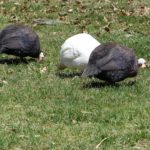
Guineas eat ticks.
A domestic bird that loves ticks is Guineas. They are tick lovers. They are African natives that have been domesticated. Elise Gallet de St Aurin, of Cheshire Moon Farms, told us the guineas that roam her farm near Atkins, Iowa, keep it clear of ticks. These attractive but loud animals roam widely, roost in trees, and eat all sorts of invertebrates, including ticks.
It’s impossible to buy or confine an opossum. But, guinea chicks can be ordered from Hoover’s Hatchery. Some people also enjoy eating guineas.
Repelling Ticks
A simple way to reduce odds that a tick will hitchhike on a person is to use repellents and chemicals that kill them. Any insect repellent containing DEET will repel ticks. Spray it heavily on the legs and arms and on clothing, especially pant legs, shoes, and socks. DEET doesn’t persist long and disappears after clothes are washed so it needs to be reapplied often.

Various forms of tick repellent.
A more permanent solution is to use a spray containing permethrin. This chemical actually kills the ticks. It lasts a long time, even through several wash cycles. It should not be applied to the skin. We spray it on our pants, socks, and shoes. One set of Permethrin-sprayed-pants remains hung in our cabin – not in the house – to put on when we are venturing in likely tick habitat.

Protect yourself with gaiters
Ticks usually access a person from down near the ground. They’re most likely to cling to pant legs or socks and then walk uphill on the skin. Tucking pants into socks makes life harder for these pesky animals, and we take it one step further. We bought a pair of tick gaiters from Forestry Suppliers, Inc. They cost about $11 and fit over shoes and pant legs, forming a tight seal.
Tick Checks
Doing a “tick check” is important. After being outside take a hot sudsy shower and check the body over for ticks. Fortunately, they usually wander around on the skin for several hours before burrowing in. A tick that has not penetrated the skin won’t spread disease and often is simply washed down the drain. Launder the clothes right away.
Ticks deserve respect. They can spread serious disease and they lurk where people often go. Don’t let a fear of ticks keep you inside. Go outside and play but take precautions to reduce the chances of catching a tick-borne illness.














